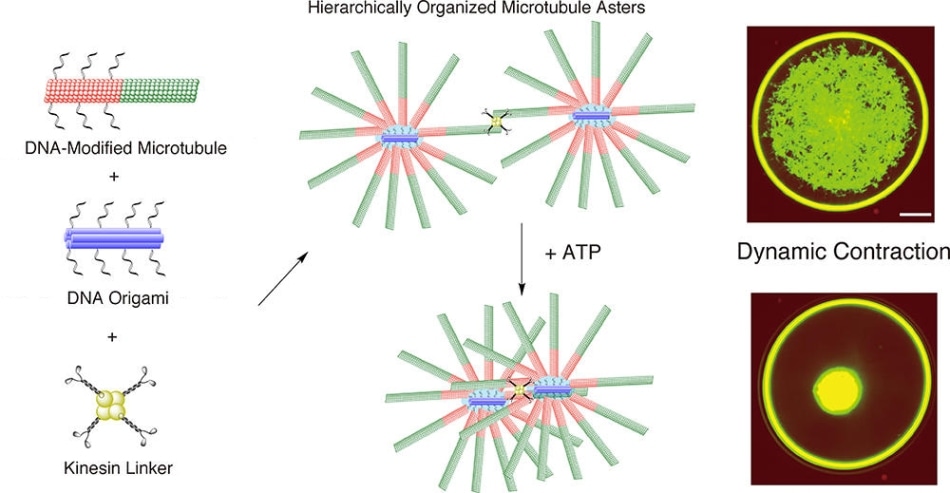Jun 3 2019
Scientists have effectively used DNA origami to create smooth-muscle-like contractions in big networks of molecular motor systems, a discovery which can be utilized in molecular robotics.
 Mixing DNA-modified microtubules, DNA origami, and kinesin linkers leads to star-like formations of microtubules that are connected by kinesin linkers. This network contracted dynamically when ATP energy was added. (Matsuda K. et al., Nano Letters, April 30, 2019)
Mixing DNA-modified microtubules, DNA origami, and kinesin linkers leads to star-like formations of microtubules that are connected by kinesin linkers. This network contracted dynamically when ATP energy was added. (Matsuda K. et al., Nano Letters, April 30, 2019)
“We successfully demonstrated programmed self-assembly of a biomolecular motor system,” write the scientists from Japan and Germany who carried out the research.
The biomolecular motor system, comprising of fibrous microtubules and motor protein kinesins, has a vital role to play in cellular transportation systems. Researchers believe they can use the motors in molecular robotics but it remains challenging to assemble a larger system from the minute molecules.
In the present study published in Nano Letters, the researchers including Akira Kakugo of Hokkaido University, Akinori Kuzuya of Kansai University, and Akihiko Konagaya of Tokyo Institute of Technology built a system integrating microtubules and DNA origami. The DNA origami was developed from six DNA helices bundled together. Blending the two components made the microtubules to self-assemble around the DNA origami developing star-shaped structures. This self-assembly was achieved by the binding of complementary DNA strands linked to each component.
The team then engineered a “kinesin linker” which is composed of four kinesin motor proteins radiating from a central core protein. These kinesin linkers linked the microtubules together, resulting in numerous star-like assemblies to connect, developing a much larger hierarchical network.
When adenosine triphosphate (ATP), a molecule which stores and conveys energy, was incorporated into the system, the kinesin linkers moved, rendering the microtubular network to dynamically contract within a short span of time. This looked a lot like the contraction of smooth muscles according to the scientists.
This dynamic contraction only occurred when the DNA origami was available, signifying the importance of the hierarchical assembly inside the microtubular network.
Further studies could lead to the use of DNA for controlled, programmable self-assembly and contraction of biomolecular motors. Such motors could find applications in molecular robotics and the development of microvalves for microfluidic devices.
Akira Kakugo, Researcher, Hokkaido University
Microtubule network showing smooth-muscule-like contraction
The microtubule network contracting in the presence of DNA origami, kinesins, and ATP. (Matsuda K. et al., Nano Letters, April 30, 2019)